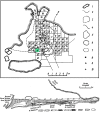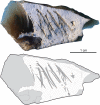Assessing the significance of Palaeolithic engraved cortexes. A case study from the Mousterian site of Kiik-Koba, Crimea
- PMID: 29718916
- PMCID: PMC5931501
- DOI: 10.1371/journal.pone.0195049
Assessing the significance of Palaeolithic engraved cortexes. A case study from the Mousterian site of Kiik-Koba, Crimea
Abstract
Twenty-Seven Lower and Middle Paleolithic sites from Europe and the Middle East are reported in the literature to have yielded incised stones. At eleven of these sites incisions are present on flint cortexes. Even when it is possible to demonstrate that the engravings are ancient and human made, it is often difficult to distinguish incisions resulting from functional activities such as butchery or use as a cutting board, from those produced deliberately, and even more difficult to identify the scope of the latter. In this paper we present results of the analysis of an engraved cortical flint flake found at Kiik-Koba, a key Mousterian site from Crimea, and create an interpretative framework to guide the interpretation of incised cortexes. The frame of inference that we propose allows for a reasoned evaluation of the actions playing a role in the marking process and aims at narrowing down the interpretation of the evidence. The object comes from layer IV, the same layer in which a Neanderthal child burial was unearthed, which contains a para-Micoquian industry of Kiik-Koba type dated to between c.35 and 37 cal kyr BP. The microscopic analysis and 3D reconstruction of the grooves on the cortex of this small flint flake, demonstrate that the incisions represent a deliberate engraving made by a skilled craftsman, probably with two different points. The lines are nearly perfectly framed into the cortex, testifying of well controlled motions. This is especially the case considering the small size of the object, which makes this a difficult task. The production of the engraving required excellent neuromotor and volitional control, which implies focused attention. Evaluation of the Kiik-Koba evidence in the light of the proposed interpretative framework supports the view that the engraving was made with a representational intent.
Conflict of interest statement
Figures









Similar articles
-
A decorated raven bone from the Zaskalnaya VI (Kolosovskaya) Neanderthal site, Crimea.PLoS One. 2017 Mar 29;12(3):e0173435. doi: 10.1371/journal.pone.0173435. eCollection 2017. PLoS One. 2017. PMID: 28355292 Free PMC article.
-
An Early Instance of Upper Palaeolithic Personal Ornamentation from China: The Freshwater Shell Bead from Shuidonggou 2.PLoS One. 2016 May 26;11(5):e0155847. doi: 10.1371/journal.pone.0155847. eCollection 2016. PLoS One. 2016. PMID: 27227330 Free PMC article.
-
An Upper Palaeolithic engraved human bone associated with ritualistic cannibalism.PLoS One. 2017 Aug 9;12(8):e0182127. doi: 10.1371/journal.pone.0182127. eCollection 2017. PLoS One. 2017. PMID: 28792978 Free PMC article.
-
A critical review of the German Paleolithic hominin record.J Hum Evol. 2006 Dec;51(6):551-79. doi: 10.1016/j.jhevol.2006.04.014. Epub 2006 Jul 25. J Hum Evol. 2006. PMID: 17014890 Review.
-
Hunters of the Ice Age: The biology of Upper Paleolithic people.Am J Phys Anthropol. 2008;Suppl 47:70-99. doi: 10.1002/ajpa.20950. Am J Phys Anthropol. 2008. PMID: 19003886 Review.
Cited by
-
Neural correlates of perceiving and interpreting engraved prehistoric patterns as human production: Effect of archaeological expertise.PLoS One. 2022 Aug 3;17(8):e0271732. doi: 10.1371/journal.pone.0271732. eCollection 2022. PLoS One. 2022. PMID: 35921273 Free PMC article.
-
A 51,000-year-old engraved bone reveals Neanderthals' capacity for symbolic behaviour.Nat Ecol Evol. 2021 Sep;5(9):1273-1282. doi: 10.1038/s41559-021-01487-z. Epub 2021 Jul 5. Nat Ecol Evol. 2021. PMID: 34226702
References
-
- Mellars P. The Neanderthal Legacy: An Archaeological Perspective from Western Europe. Princeton: Princeton University Press; 1996.
-
- Mellars P. The Neanderthal Problem Continued. Current Anthropology. 1999;40: 341–364. doi: 10.1086/200024 - DOI
-
- Mithen S. The prehistory of the mind: a search for the origins of art, science and religion London and New York: Thames and Hudson; 1996.
-
- Bar-Yosef O. The Upper Paleolithic Revolution. Annual Review of Anthropology. 2002;31: 363–393.
-
- Stringer C, Gamble C. In Search of the Neanderthals: Solving the Puzzle of Human Origins London: Thames and Hudson; 1993.
Publication types
MeSH terms
Grants and funding
LinkOut - more resources
Full Text Sources
Other Literature Sources


